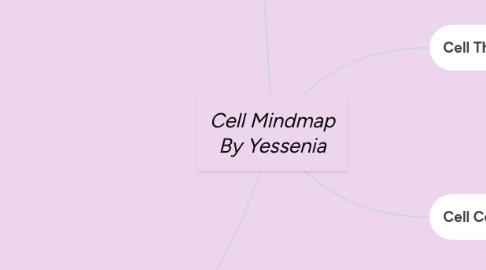
1. Types of Cells: Prokaryotic Vs. Eukaryotic
1.1. Prokaryotic Cells
1.1.1. - DNA (in single circular chromosome) in nucleoid
1.1.2. - No membrane
1.1.3. - Simpler structure
1.1.4. - May have extra small circular DNA (plasmid)
1.1.5. - May have cell wall made of peptidoglycans
1.2. Eukaryotic Cells
1.2.1. - Much bigger/larger size
1.2.2. - Diverse shapes
1.2.3. - Chromosomes contained in nucleus
1.2.4. - Nucleus enclosed by nuclear envelope (membrane)
1.2.5. - Contain membrane-enclosed organelles
2. Eukaryotic Cell Organelles
2.1. Nucleus
2.1.1. Contains most genes
2.1.2. DNA
2.2. Nuclear Envelope
2.2.1. 2 lipid bilayers
2.3. Nucleolus
2.3.1. Contains DNA, RNA, proteins & subunits
2.3.2. Function: rRNA synthesis & assembly of rRNA with proteins to form ribosomal subunits
2.4. Ribosomes
2.4.1. Made of rRNA & protein
2.4.2. Each ribosome has a small & large subunit that completes protein synthesis in cytoplasm or internal membranes
2.4.3. Synthesizes proteins
2.4.4. Free ribosomes: in cytosol
2.4.5. Bound ribosomes: attached to the ER
2.5. 2 Types of Endoplasmic Reticulum
2.5.1. Smooth ER
2.5.1.1. Tube-like portion/shape
2.5.1.2. Lacks ribosomes
2.5.1.3. Synthesizes lipids
2.5.1.4. Metabolizes carbs
2.5.1.5. Detoxifies poison
2.5.1.6. Stores calcium
2.5.2. Rough ER
2.5.2.1. cisternae (sac-like) portion/shape
2.5.2.2. Ribosomes attached to outside
2.5.2.3. Bound ribosomes secrete glycoproteins
2.5.2.4. Distribute transport vesicles
2.5.2.5. Membrane factory
2.6. Golgi Apparatus
2.6.1. Shipping & Receiving Center
2.6.1.1. Function: packages & distributes synthesized molecules
2.6.1.2. Cis & trans faces
2.7. Lysosomes
2.7.1. Membrane-bound sacs containing hydrolytic enzymes (catalyze hydrolysis reacations)
2.7.2. Lysosome enzymes hydrolyze proteins, fats, polysaccharides & nucleic acids
2.7.3. Lysosome enzymes have a pH 5
2.7.4. Lysosomes have compartmentalization
2.7.5. Arise from Golgi Apparatus
2.7.6. Synthesized by RER & transported by the Golgi Apparatus, vesicles pinch Golgi then remain in cytoplasms until they fuse into mature lysosomes
2.7.7. Function: Digestion of food by phagocytosis & autophagy (fusing with worn out or damaged cells, aka recycling)
2.8. Mitochondria
2.8.1. Enery Transformer
2.8.1.1. Site of cellular respiration: catabolism of sugar, fats, etc to make ATP
2.8.1.2. Double membrane (smooth outer membrane & inner cristae membrane)
2.8.1.3. Made of intermembrane space (proteins carried out cellular respiration) & matrix (circular DNA & ribosomes)
2.9. Chloroplasts
2.9.1. Energy Transformers
2.9.1.1. Photosynthetic site (anabolic pathways)
2.9.1.2. Found in leaves/plants & eukaryotic algae
2.9.1.3. Cytoplasmic streaming
2.9.1.4. Surrounded by outer & inner membrane
2.9.1.5. Inner membrane, stroma, thylakoid space, DNA & ribosomes
2.9.1.6. Thylakoid space: generates H+ concentration gradients
2.9.1.7. Stroma: contains DNA, ribosomes, & other enzymes involved in photosynthesis
